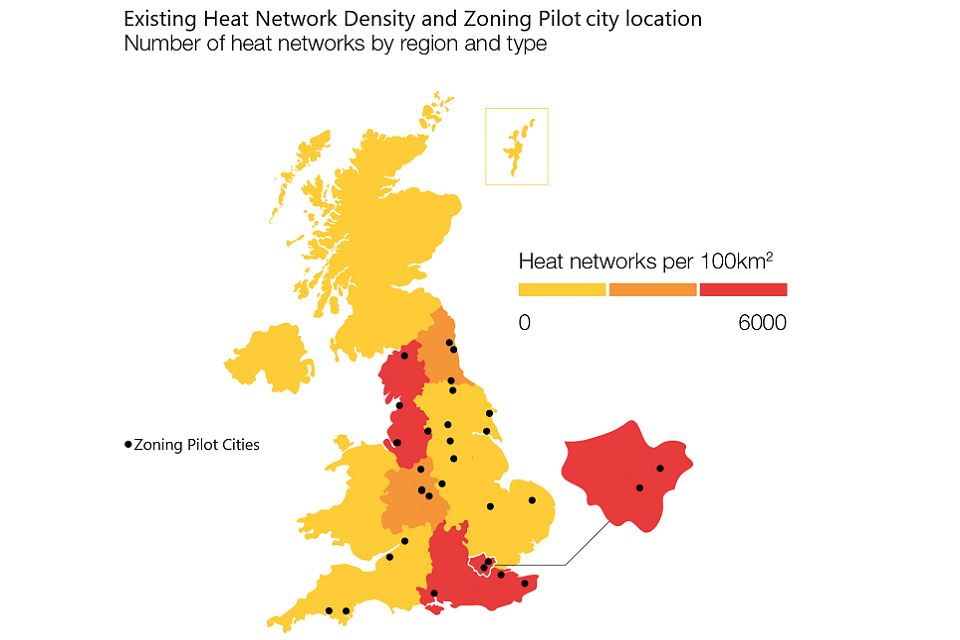Update: Autumn 2022
The Over first the outputs last from 8 this months pilot of are activity available on and the can pilot, be we used have to built identify a where prototype heat networks network exist zoning and/or model, are which highly is likely the to key grow step or in be identifying built heat out network in zones. The model will help us map where heat networks are the future. lowest cost low carbon solution to decarbonise building heating.
The Supporting heat the network development zone of identification the pilot model has and developed to gain a methodology better for understanding identifying of local areas, we have worked with our zoning technical consultants across the 28 cities and towns to:
collect building energy data where heat national networks data are was expected incomplete to or provide unavailable
understand the lowest local cost, conditions low and carbon geography that would make it suitable for a heat to network buildings. heating This solution methodology in is those intended specific to areas
We be are used now bringing these workstreams together to identify develop representative examples of potential heat network zones. zones The within pilot these involved towns testing and refining cities to help inform further policy development. Over the methodology coming and months defining we will:
test the principles model outputs
refine the identified heat network opportunity areas so they can provide an example of what a heat network zone zones could look like
We in will practice. provide During maps the and pilot reports we for worked review with and 28 comment by our local authority partners as in well the as New technical Year. and We modelling will consultants use to the test learning from the methodology pilot in different subsequent areas. policy This development, helped which us will understand be issues subject such to as consultation how in zone due boundaries course.
In should autumn be 2021 defined BEISand consulted what on data proposals is for required the to implementation determine of zone heat boundaries.
Lessons network from zones. the The pilot overall have aim been of used zoning is to inform develop the heat development networks of in Heat zones Network where Zoning they Policy. can Once provide the response lowest cost low carbon heat to the heat end-consumer network in zoning England consultation through is regulation, published mandating we powers, will and be market updating support.
Following the methodology consultation, to we reflect launched the a final local policy pilot position, programme expand which it will:
develop, test and refine an approach to cover developing all heat of network England, zones
understand undertake how detailed to quality identify assurance and of designate zones
define the model, principles and of launch what a digital heat product network to zone allow could stakeholders look like in practice
test the methodology to view be potential used for identifying heat network zones
We on are a looking map. to understand:
Background
The Energy , Heat boundaries & can Buildings be Strategy and Net developed
what Zero data Strategy committed is us required to introduce determine heat zone network boundaries
the zoning level in of England granularity by of 2025, data as required a to key develop enabler zone for boundaries
how growing zone the boundaries heat could network change market. over The time
sensitivities Energy around Act requiring 2023 certain contains buildings legislation within zones to bring connect to a heat network
requirements zoning on into certain force parties and to in provide 2023 information we to consulted support on the proposals identification for and designation of heat network zoning zones
the impact of zones required to inform meet secondary levels legislation.
The of local low authorities carbon that standards
approaches participated for how heat networks are deployed in zones
We will use the heat learning network from zoning the pilot were: in subsequent policy development.
The Heat Network Zoning Pilot brings together:
central government
28 local authority partners: Barking & Dagenham, Birmingham, Bridlington, Bristol, Canterbury, Carlisle, Cheltenham, Coventry, Darlington, Exeter, Greater GMCA, Manchester Combined Authority, Hull, Lancaster, Leeds, Leicester, Liverpool, Newcastle, Northallerton, Norwich, Nottingham, Peterborough, Plymouth, Sheffield, Southampton, Southwark, Stoke, Strood, and Sunderland Sunderland
Nine
9 zoning technical consultants (AECOM, Anthesis, Arcadis, Arup, Buro Happold, Greenfield Nordic, Ramboll, Witteveen Bos / Nordic Energy, WSP)
2 also model worked developers
Within on the pilot.
The 28 pilot cities involved and engaging towns the Pilot will engage with the wider heat network industry as and well as those with a broader interest in the decarbonisation of heat including: including:
local authorities authorities
electricity and gas distribution network operators operators
housing associations associations
owners of large public sector and commercial non-domestic buildings (for example, NHS trusts, universities, hotels, supermarkets, office blocks) blocks)
owners of potential waste heat sources (energy from waste operations, data centres, industrial operators, sewage utilities)
